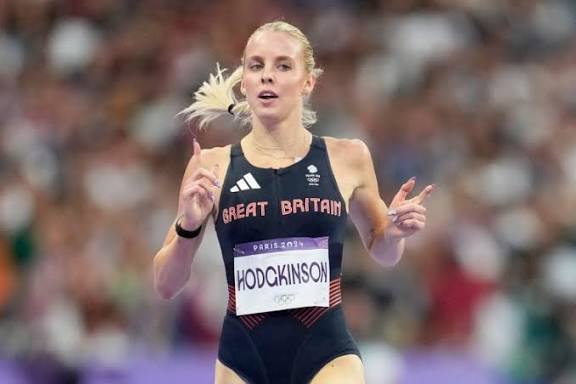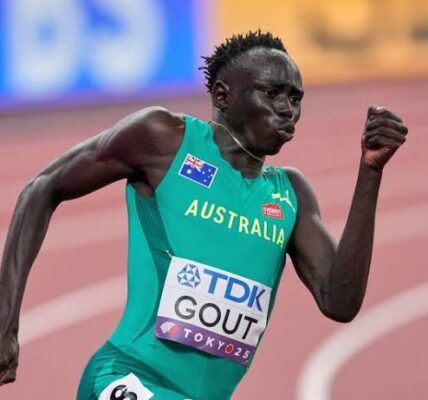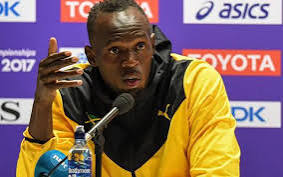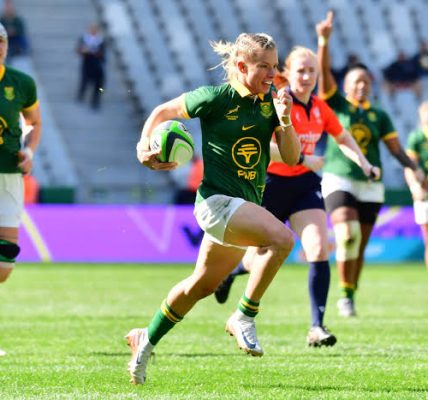Skip to content
Keely Returns With 1:54 , Kipyegon Nearly Breaks WR, Thompson Beats Lyles.
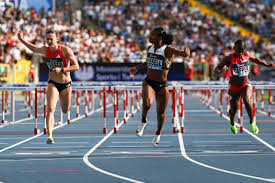
The 2025 Diamond League season resumed on Saturday with the 2025 Kamila Skolimowska Memorial meeting in Silesia, Poland, highlighted by a pair of fast times from Olympic champions Keely Hodgkinson (1:54.74 WL in the 800) and Faith Kipyegon (8:07.04 in the 3000, #2 all-time) and Diamond League records in the hurdles by Masai Russell (12.19 in 100m hurdles) and Karsten Warholm (46.28 in the 400m hurdles).
American Yared Nuguse also closed hard to pick up his fourth career DL victory in the men’s 1500 (3:33.19) while Melissa Jefferson-Wooden stayed red-hot to win the women’s 100 (10.66) and Kishane Thompson defeated Noah Lyles in their Olympic 100m rematch, 9.87 to 9.90.
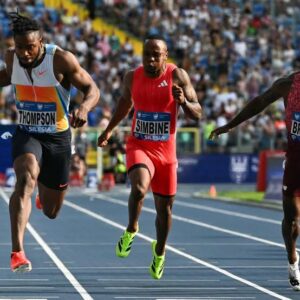
Below, eight takeaways from a great afternoon of track in sunny Silesia.
1) Keely Hodgkinson looks as good as ever
There are two ways to make a comeback. One is to ease your way in and build up gradually.
The other is to hold off until you feel you are back to your best, then come out firing.
It’s pretty clear which option Olympic champion Keely Hodgkinson chose after she ran a world-leading 1:54.74 to win the women’s 800 on Saturday in her first race in 376 days.
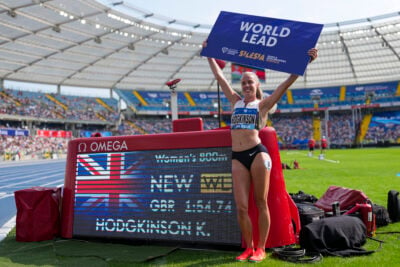
(Diamond League AG for Diamond League AG)
Given Hodgkinson has had multiple setbacks with her hamstring injury this year (remember, she had initially planned on coming back for an indoor race in February), there was plenty of speculation as to how ready she would be with the World Championships just four weeks away.
But on the world feed, commentator Tim Hutchings said that Hodgkinson had been working out in spikes for six weeks and that her coach Trevor Painter told him he thought she was in close to world record shape (1:53.28).
Hodgkinson looked incredible today. She got to the lead immediately and showed no fear in going through 400 in an aggressive 56.7.
Then Hodgkinson blew apart the field on the second lap, closing well with a 29.3 final 200m to win in 1:54.74 – just .13 off her pb and almost two seconds in front of runner-up Lilian Odira of Kenya, who PR’d by almost two seconds to run 1:56.52.
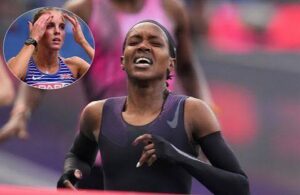
That margin shows you just how far ahead of the rest of the world Hodgkinson is right now, because Odira’s time is the second-fastest by a woman in 2025. Hodgkinson is now the clear favorite for Worlds.
The times were very fast behind Hodgkinson. In addition to Odira, Botswana’s Oratile Nowe took almost a second off her pb to run 1:56.76 (#5 in the world this year), American Raevyn Rogers ran her best race of the year to take 4th in 1:57.52, and 20-year-old Claudia Hollingsworth ran an Australian record of 1:57.67 for 5th – just .03 ahead of fellow Aussie Abbey Caldwell.
2) It was hard not to think of Athing Mu-Nikolayev while watching the 800
Athing Mu-Nikolayev and Keely Hodgkinson have a lot in common.
They are both 23 years old, both Olympic champions, and both have 1:54 personal bests.
And they were both making comebacks in 2025 – Mu-Nikolayev from a torn hamstring and devastating fall at last year’s Olympic Trials, Hodgkinson from her own hamstring injury.
Mu-Nikolayev has been healthy all season yet her season’s best is just 1:59.79 and she could not even make the final at USAs.
Hodgkinson, meanwhile, returned as good as ever and is once again the favorite for Worlds.
Both are A+ talents, but while Hodgkinson trains under one of the world’s best middle-distance coaches in one of the world’s best middle-distance groups, Mu-Nikolayev trains largely alone under a sprint coach, Bobby Kersee.
One has to wonder how each woman’s comeback would have gone if their training setups were reversed.
World Athletics will not recognize Kipyegon’s 8:07.04 today as the official world record in the 3,000 meters, but many track fans will view it that way given the skepticism around Wang Junxia’s 8:06.11 from 1993 (reports surfaced in 2016 of a letter signed by Junxia and nine Chinese women others who said they had been forced to take performance-enhancing drugs in the 1990s).
It was a sensational run that ranks #2 on the all-time list, well ahead of the previous #2, Beatrice Chebet’s 8:11.56 from Rabat earlier this season.
Kipyegon was aided by terrific pacing from American Sage Hurta-Klecker (who went through 1200) and Olympic silver medalist Jessica Hull (who lasted until 2k), hitting 1k in 2:42.8 (WR pace is 2:42.03) and 2k in 5:25.7 (WR pace is 5:24.07).
Kipyegon was grimacing towards the end but hit the bell with a shot at the record – she needed a 62.0 and came just short, running a 62.9.
Kipyegon and her pacers did everything right. It’s just a very hard record to break.
The weather (83 degrees Fahrenheit, partly cloudy) was not ideal but similar to the conditions Jakob Ingebrigtsen faced when he ran his 7:17.55 men’s 3k world record in Silesia last summer.
“I am very satisfied with the time,” Kipyegon said. “I saw the world record red line during the race but today it was very hot. I want to come back here next year.”
For decades, Junxia’s 8:06.11 was unreachable, a distant speck on the horizon for even the world’s best female distance runners.
That has changed in 2025. Perhaps Kipyegon returns to Silesia next year and breaks it. Perhaps Chebet beats her to the punch.
But it’s no longer crazy to suggest a woman could run faster than 8:06.
Those two Kenyan superstars have taken a previously unbreakable record and brought it to within touching distance.
After finishing 5th at USAs, Nuguse needs to win the Diamond League 1500 final if he is to make it to the World Championships this year. So far, so good.
He won in Silesia on Saturday in 3:33.41 to move to 4th in the Diamond League standings, which means he will almost certainly qualify for the 10-man final in Zurich (Nuguse will also race in Brussels next week).
He did so by taking control of the race with 200 meters to go and closing in a strong 25.7 for the win.
On paper, this was a field Nuguse should have beaten – there was no Cole Hocker, Josh Kerr, Jakob Ingebrigtsen, or Phanuel Koech. Nuguse took care of business.
Perhaps wary of leading after it backfired at USAs, Nuguse backed off a bit early but was never lower than 4th after the first 100 meters and was in position to strike on the last lap in a slow race (by 2025 DL standards).
When Narve Nordas made a bid for the lead on the back straight, Nuguse responded immediately and got the lead by 200 to go, which allowed him to run the shortest distance and control the final half-lap, unlike, for example, Kenya’s Reynold Cheruiyot, who closed like a train (12.1 final 100) but was boxed in in 10th place with 200 to go.
Nuguse will face stronger competition in Zurich, but this was a good way to kick off his post-USAs European tour.
Nuguse has now won four Diamond League 1500s – London and Zurich in 2023, Zurich in 2024, and Silesia in 2025.
In the 16-year history of the Diamond League, Leo Manzano (2011 London) and Jonah Koech (2025 Rabat) are the only other American men with even one DL 1500/mile victory.
There were two other Americans in Saturday’s race.
Josh Hoey was 5th in 3:33.75 – a solid result, but proof that he should focus on the 800 for the rest of the year (His coach Justin Rinaldi confirmed Hoey would run the 800 at the Diamond League final in the chat of our live Silesia recap show).
Hobbs Kessler, meanwhile, was only 7th in 3:34.14.
Kessler, who was 10th at the Pre Classic, only has two Diamond League points with just one DL 1500 remaining next week in Brussels.
At this point, he’s a long shot to even make the 10-person final, let alone win it to earn the wild card to Worlds.
For results and interviews from 1500, click here: Nuguse: “I feel very confident about my chances of winning there [at Worlds]”
5) Once again, Gudaf Tsegay was equal parts impressive and frustrating in the women’s 1500
Running 3:50.62 – a time surpassed by just three other women – and winning a Diamond League 1500 by 4+ seconds is no small feat, so what Ethiopia’s Gudaf Tsegay did in Silesia on Saturday deserves plenty of respect.
But while Tsegay’s fitness is phenomenal, her tactics once again held her back from running even faster.
In her last race, a mile in London on July 19, Tsegay went out in 60.0 – so fast that she had already passed the pacers by that point.
In Silesia, she went out even faster (59.3), though the pacers were still ahead of her this time.
She hit 800 in 2:00.4 (60.1) but slowed to 3:03.1 at 1200 (62.7) and then held on for a 47.5 final 300 (63.3 400m pace).
One hundred years of running history tells us the best way to run your fastest 1500 is to run close to even splits, yet Tsegay hit 800m more than a second and a half under world record pace (2:01.96) before holding on for dear life over the second half.
She may not have run the world record today with a more conservative start, but we’d love to see what Tsegay could do if she runs just a bit more conservatively.
5k/10k world record holder Beatrice Chebet was also in this race and ran 3:54.73 in the first non-altitude 1500 of her life.
Chebet went out fairly quickly (60.8 through 400) but backed off in the middle stages before kicking it in with a 61.6 final 800 to finish a clear 2nd ahead of Olympic bronze medalist Georgia Hunter Bell (3:56.00) and US champ Nikki Hiltz (3:56.10).
This was an odd race for her given Tsegay built such an enormous lead early on, but I have no doubt Chebet could have run a few seconds faster if she had someone like Jessica Hull to chase today.
6) Kishane Thompson wins Olympic rematch, but Noah Lyles is coming
In their first head-to-head matchup since last year’s Olympic 100m final, silver medalist Kishane Thompson defeated gold medalist Noah Lyles, 9.87 to 9.90, as the two shape up for what should be a compelling rematch at next month’s World Championships in Tokyo.
The Jamaican got out well but Lyles closed hard as usual, and looked much better today than he did in his 100m opener in London (10.00, -0.6) or USAs (10.05, +0.1).
Thompson’s form grew sloppy in the final meters, swaying from the far right of his lane to the far left, a problem he acknowledged after the race.
“My race today was not so good, not so bad,” Thompson said. “I enjoyed [the] competition against Noah today.
It is all about execution: I had problems with that, but I am finding it.
The key is to find the momentum in the race and to maintain it till the end.”
Lyles, meanwhile, was very pleased with his result.
After a foot injury kept him from racing for three months this spring, he is getting better with every race.
“It is a great stepping stone,” Lyles said. “I needed to see a sub-10.
I needed to see winning, beating people, I took out some really big heads today, people who run 9.7 and 9.8. I am getting the confidence.
It makes me really excited for not only today but also for next week and Tokyo.
The more I run, the better I am getting. I get more excited each day and it is working.
I need to keep competing. I think we will see some really good races in Lausanne.”
One man who will be disappointed with his race today is Kenny Bednarek.
After taking on a heavy workload at USAs, including a 9.79 to win the 100m final, he was just 3rd in 9.96, well behind his two biggest rivals for gold.
This event is coming together nicely for the World Championships.
Thompson is younger and has a higher ceiling than Lyles, but Lyles is stronger at the end of races and holds his form better.
The two men are scheduled to race again in Lausanne on Wednesday before the big one in Tokyo on September 14.
Earlier our headline said Thompson was undefeated in 2025 in the 100m. That is incorrect. He was 2nd in the Shanghai DL meet on May 3rd.



